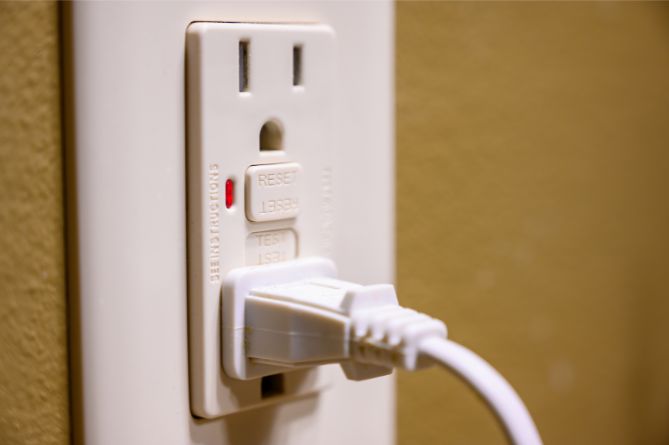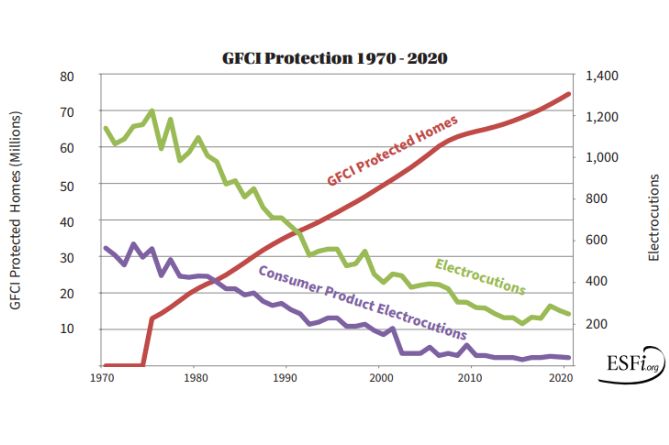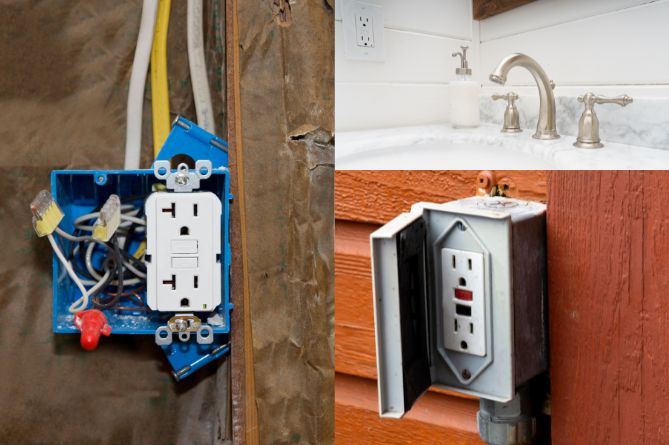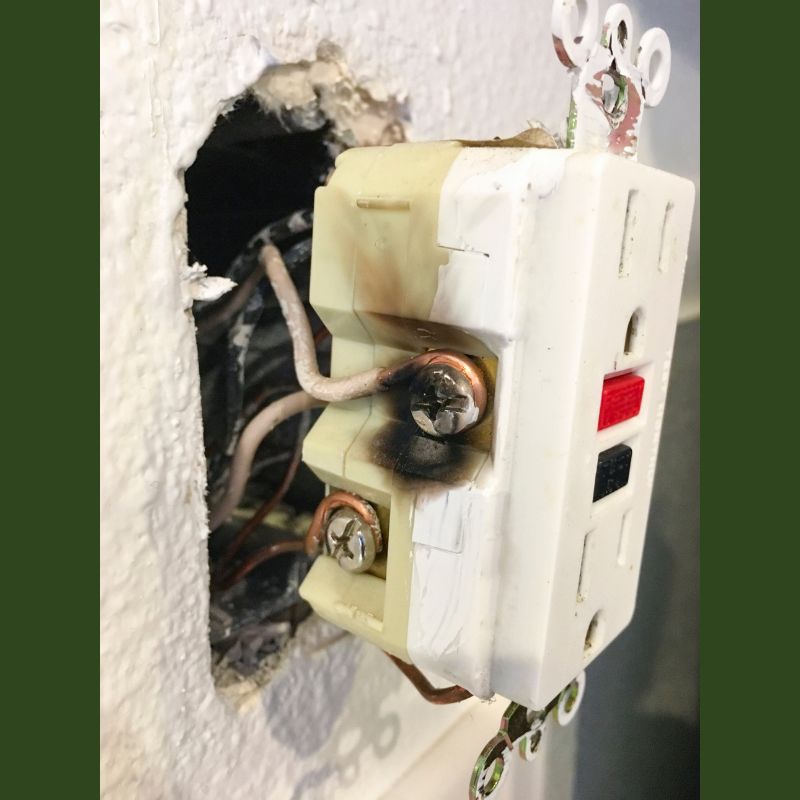Understanding GFCI Outlets:
A Safety Must Have
It’s probably safe to assume that most of us were taught early on in life that electricity and water are a dangerous combination. The reason is simple: water can provide electricity with an easy path into our bodies, leading to electrical shock or worse!
For decades, electrical risks in the wetter parts of our home were simply a part of life – and electrical shock was not uncommon. However, rather than simply tolerate a certain number of electrocutions per year, the National Electrical Code (NEC) has been progressively making our homes safer by requiring protective systems like ground fault circuit interrupters (GFCIs).
This article will examine how GFCIs work, discuss where they are most useful, and explain how to ensure that your GFCI devices are working properly!

What is a GFCI Outlet?
A Ground Fault Circuit Interrupter outlet is a special type of electrical outlet designed to enhance safety. The primary function of a GFCI outlet is to quickly cut off electrical power when it detects a ground fault, which is a situation where electricity is escaping the circuit. This could happen, for example, if someone touches an electrified appliance with wet hands.
How Does a GFCI Outlet Work?
Before we dive into how GFCIs work, it’s important to briefly explain how outlets work:
Outlet receptacles have three holes; the two flat sections are the hot and the neutral connections, while the third connection is for ground. Under normal conditions, there is a continuous flow of electricity out from your outlet via the hot wire, into your electrical device, and then back into your home through the neutral wire.
While it’s easy to imagine that electricity is being ‘used up’ inside of your devices, it is in some ways more accurate to imagine electrical current flow as a stream of water that pushes water wheels. Even though the wheel (your device) is spun by the incoming water (hot wire), there is still a continuous output of water at the other end (neutral wire).
However, when things go wrong, instead of electricity returning along the neutral wire it instead finds a new path to ground – a leak. Sometimes this path is through our bodies, while other times it is through a short circuit in our electrical wiring.
Ground fault interrupters detect when there is an imbalance between the energy going out through the hot wire and the energy flowing back in through the neutral wire. Even as little as 4 to 6 milliamps discrepancy is enough to trip a GFCI, shutting off electricity to the circuit.
Why Are GFCI Outlets Important?
The single most important reason to install GFCI outlets is to protect against electrical shock. Shocks occur when electricity is able to leave the electrical system and enter into a human body. However, when this happens the electrical flow into the neutral wire will be diminished – triggering the GFCI outlet and protecting against serious injury.
GFCI breakers can trip within one tenth of a second of detecting a fault, turning potentially life threatening shocks into tiny zaps.
The impact of GFCI outlets is undeniable: electrocutions in bathrooms (where GFCIs were first mandated) dropped by 80% after their introduction. Consumer product related electrical shocks have fallen even more, dropping by 93% according to the Electrical Safety Foundation.

Where Should GFCI Outlets Be Installed?
GFCI outlets were first required to be installed in bathrooms in 1973, and over time the National Electrical Code has expanded the GFCI requirements.
High Moisture Areas
GFCI protection is required on every outlet within 6 feet of a water source. This includes bathrooms, kitchens, laundry rooms, and wet bars.
Outdoor Spaces
As of the 2020 revision of the NEC handbook, GFCI circuit breakers are required on all* outdoor outlets, including those used for air conditioning units.
*There are limited exceptions such as electronic snow melting equipment – but in most cases it is safe to assume that your outdoor outlets should have GFCI installed.
Indoor Areas
Garages, basements, and crawl spaces all are required to have GFCI receptacles. Prior to the 2020 changes, only unfinished basements were required to have protection – but the newer version now requires it for all basement outlets.

Testing and Maintaining GFCI Outlets
A quick note: not all types of GFCI protection are built into the outlet! The GFCI protection can be built into your circuit breaker, allowing the entire circuit to use standard outlets and still retain protection. If you do not see a test button on your outlet, check your breaker box and see if the individual circuit breakers include protection.
Not sure what you’re looking at in your breaker box? Check out our article on understanding your electrical panel!
Regular Testing
To ensure your GFCI outlets remain functioning, it is recommended that you test them monthly. Testing is quite simple: GFCI outlets usually have a test/reset button on their face. Press the test button and the reset button should pop out and power to the outlet should be shut off. To reset, simply press the reset button!
If your GFCI protection is in your circuit breaker box then you’ll need to follow the same procedure there.
If an outlet’s test button no longer works, then the outlet is malfunctioning and needs to be replaced.
Signs of Malfunction
There are a few common signs of GFCI malfunction:
- The protection trips often – even when no apparent short circuit is present.
- The outlet no longer functions.
- The test button no longer trips the outlet.
- Flashing indicator lights. Some newer GFCI outlets include LED indicator lights which can signal malfunctions.
- Scorch marks. This goes for any outlet. If you see signs of burning or scorching, something is wrong!
Age. GFCI outlets over 10 to 15 years of age should be replaced even if they are functioning.
If any of these conditions are present, the outlet should be replaced.

Replacement and Installation
Replacing a GFCI outlet is as easy (or as complicated depending on your perspective) as replacing a standard outlet. If you feel comfortable performing this type of DIY project, then it should be within your abilities.
However, if your GFCI protection is built into your breaker box or aren’t confident in your ability to perform an outlet replacement, we recommend contacting a licensed electrician.
GFCI Outlets are a Key Component of Electrical Safety
Today, our home’s electrical systems are safer than ever. Technology like GFCI protection have vastly reduced the number of electrocutions and electrical shocks across residences in America. But, this protection only works if it is kept in good working order and homeowners should routinely check their GFCI protection.
If you suspect one of your GFCI outlets is not working correctly, have your local electrician replace it and keep your family safe!
